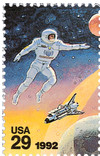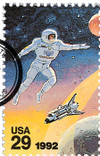
# 2631 - 1992 29c Space Accomplishments: Soviet Cosmonaut
US #2631
1992 Russian Cosmonaut
- Part of a block of four
- Issued to commemorate space achievements
- Joint issue with Russia
- Se-tenant block of four forms a space scene
Category of Stamp: Commemorative
Set: Space Accomplishments
Value: 29¢, First Class Mail rate
First Day of Issue: May 29, 1992
First Day City: Chicago, Illinois
Quantity Issued: 37,315,000
Printed by: Bureau of Engraving and Printing
Printing Method/Format: Photogravure, printing cylinders of 200 (10 across, 20 down) separated into panes of 50 (10 across, 5 down)
Perforations: 11
Joint Issue: with Russia #6083a
Reason the stamp was issued: This stamp is part of a block of four issued with Russia to commemorate past accomplishments in space and envision future joint ventures.
About the stamp design: This stamp shows a Russian cosmonaut in his spacesuit. Below him is a US Space Shuttle and a portion of the moon. Part of the planet Mars can be seen at the top right of the stamp.
The designs of the four stamps in this block flow together to form a continuous scene, but each stamp can stand on its own. Robert McCall was chosen to create the artwork for the stamps. He is a space artist whose work can be seen on the Accomplishments in Space (#1331-32), Space Achievement Decade (#1434-35), and Space Achievement (#1912-19) stamps. He worked with Russian artist Vladimir Beilin, who had designed two of the Creatures of the Sea joint issue stamps.
The stamps picture contributions to space exploration from both countries. These include the Apollo-Soyuz mission, satellites, a space station, and more. A possible future joint manned trip to Mars is also depicted at the top of the stamp block.
Special design details: In the original design, the Soviet cosmonaut had the letters CCCP (the USSR in the Cyrillic alphabet) on his spacesuit, while the American astronaut’s had USA. When the USSR collapsed, this had to be changed. It was decided that the names of each country’s space agency would be displayed instead, so the American’s suit shows NASA and the Russian’s has the emblem for Glavkosmos.
When plans for the joint issue were first made, it was agreed that the stamps would be produced in a larger size and 32-stamp panes. The US stamps were printed in standard commemorative size, with 50 stamps to a pane.
The colors on the Russian stamp were not true to the original paintings. This may have been because of difficulties in getting proper ink supplies in the midst of the upheaval.
First Day City: The First Day of Issue ceremony took place during the final days of the World Columbian Stamp Expo 92, held in a Chicago suburb. Two American astronauts and a Russian cosmonauts attended the dedication. The Russian version of the stamps was dedicated the same day at a cosmonaut training center near Moscow.
Unusual thing about this stamp: Planning began for this joint issue began in 1990. At the time, US postal officials met with their Soviet Union counterparts. They agreed that an artist from each country would be work together to design the block of four. These artists would then produce identical paintings for their countries to use for the stamps. The following year, the Soviet Union collapsed. This drastic turn of events led to uncertainty about the planned joint issue. At the end of 1991, the USPS assured the public that the Space block would be issued, but no one was sure if it would be a joint issue or what the other country would be.
As the eventful year ended and 1992 began, communications between US postal authorities and Russian officials continued. Changes had to be made to the design to reflect the new reality of Russia’s space program.
About the Set: This stamp is part of a block of four issued with Russia to display both countries’ accomplishments in space.
History the stamp represents: Though the US and the Soviet Union were on opposite sides of the Cold War, the two countries began to work together to advance space exploration. The Apollo-Soyuz mission was the first joint venture. In July 1975, a US Apollo spacecraft docked with a Soviet Soyuz capsule. The Americans and two Soviets performed experiments together. This first mission led to the later development of the International Space Station.
US #2631
1992 Russian Cosmonaut
- Part of a block of four
- Issued to commemorate space achievements
- Joint issue with Russia
- Se-tenant block of four forms a space scene
Category of Stamp: Commemorative
Set: Space Accomplishments
Value: 29¢, First Class Mail rate
First Day of Issue: May 29, 1992
First Day City: Chicago, Illinois
Quantity Issued: 37,315,000
Printed by: Bureau of Engraving and Printing
Printing Method/Format: Photogravure, printing cylinders of 200 (10 across, 20 down) separated into panes of 50 (10 across, 5 down)
Perforations: 11
Joint Issue: with Russia #6083a
Reason the stamp was issued: This stamp is part of a block of four issued with Russia to commemorate past accomplishments in space and envision future joint ventures.
About the stamp design: This stamp shows a Russian cosmonaut in his spacesuit. Below him is a US Space Shuttle and a portion of the moon. Part of the planet Mars can be seen at the top right of the stamp.
The designs of the four stamps in this block flow together to form a continuous scene, but each stamp can stand on its own. Robert McCall was chosen to create the artwork for the stamps. He is a space artist whose work can be seen on the Accomplishments in Space (#1331-32), Space Achievement Decade (#1434-35), and Space Achievement (#1912-19) stamps. He worked with Russian artist Vladimir Beilin, who had designed two of the Creatures of the Sea joint issue stamps.
The stamps picture contributions to space exploration from both countries. These include the Apollo-Soyuz mission, satellites, a space station, and more. A possible future joint manned trip to Mars is also depicted at the top of the stamp block.
Special design details: In the original design, the Soviet cosmonaut had the letters CCCP (the USSR in the Cyrillic alphabet) on his spacesuit, while the American astronaut’s had USA. When the USSR collapsed, this had to be changed. It was decided that the names of each country’s space agency would be displayed instead, so the American’s suit shows NASA and the Russian’s has the emblem for Glavkosmos.
When plans for the joint issue were first made, it was agreed that the stamps would be produced in a larger size and 32-stamp panes. The US stamps were printed in standard commemorative size, with 50 stamps to a pane.
The colors on the Russian stamp were not true to the original paintings. This may have been because of difficulties in getting proper ink supplies in the midst of the upheaval.
First Day City: The First Day of Issue ceremony took place during the final days of the World Columbian Stamp Expo 92, held in a Chicago suburb. Two American astronauts and a Russian cosmonauts attended the dedication. The Russian version of the stamps was dedicated the same day at a cosmonaut training center near Moscow.
Unusual thing about this stamp: Planning began for this joint issue began in 1990. At the time, US postal officials met with their Soviet Union counterparts. They agreed that an artist from each country would be work together to design the block of four. These artists would then produce identical paintings for their countries to use for the stamps. The following year, the Soviet Union collapsed. This drastic turn of events led to uncertainty about the planned joint issue. At the end of 1991, the USPS assured the public that the Space block would be issued, but no one was sure if it would be a joint issue or what the other country would be.
As the eventful year ended and 1992 began, communications between US postal authorities and Russian officials continued. Changes had to be made to the design to reflect the new reality of Russia’s space program.
About the Set: This stamp is part of a block of four issued with Russia to display both countries’ accomplishments in space.
History the stamp represents: Though the US and the Soviet Union were on opposite sides of the Cold War, the two countries began to work together to advance space exploration. The Apollo-Soyuz mission was the first joint venture. In July 1975, a US Apollo spacecraft docked with a Soviet Soyuz capsule. The Americans and two Soviets performed experiments together. This first mission led to the later development of the International Space Station.











